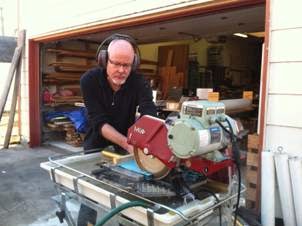Start with
clean cullet. Rinse or wash off all the dust and felt tip marks. Spread out to
dry, or put the collection in the kiln at about 200C to dry.
 |
| An example of clear glass cullet |
It is
possible to start with the dry glass, or you can heat the glass to a
temperature in the 300C to 450C range in a stainless steel container. Then take the hot container with heat
resistant gloves and pour the hot glass into a bucket of water (do not pour the
water onto the glass, as a great deal of steam will be produced burning
you). The fractured glass can then be
further broken down in size after being dried.
Smashing
the glass can be done in a number of ways.
A small amount can be made in a mortar and pestle. Larger amounts can be put between sheets of
newspaper, in plastic bags or any other container that will keep the glass from
shooting all over. Hit the glass package
with a hammer multiple times.
You can
build a frit maker from pipes with end caps.
Fit one pipe inside the other with the glass between the ends and pound
the glass between the two surfaces.
There are a number of variations on this method of production.
 |
| An example of a commercially available frit maker |
Large scale
frit production can use coffee grinders, or adapted waste disposal units. Waste
disposal units tend to produce a lot of frit of the same size, while coffee
grinders with blades produce frit sizes related to the time the glass is ground.
 |
| Example of a suitable coffee grinder |
 |
| Example of a garbage disposal unit |
When you
have created a pile of frit, sieve it into various sizes with screens. It is best to discard the fine frit and
powder, as they contain contaminants that are difficult to clean out and will
discolour the finished product.
 |
| Example of a commercially available set of seives |
You also need
to ensure the metal is removed from the glass by using a strong magnet. Fridge magnets will not do. Put the magnet in a plastic bag and run it
over the frit several times. When
finished take the bagged magnet to the waste bin and remove the magnet. The metal will fall into the bin.
 |
| Example of a pair of strong magnets |
It is a
good idea to rinse the remaining frit to remove dusts and ensure the frit is
clean. Again you can put the frit on a
metal tray in the kiln to dry. Put the
frit into a closed container to keep it clean until needed for use.


























